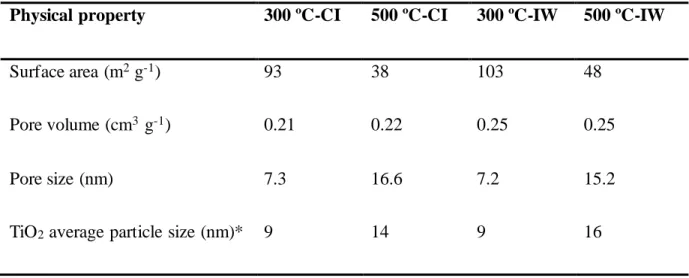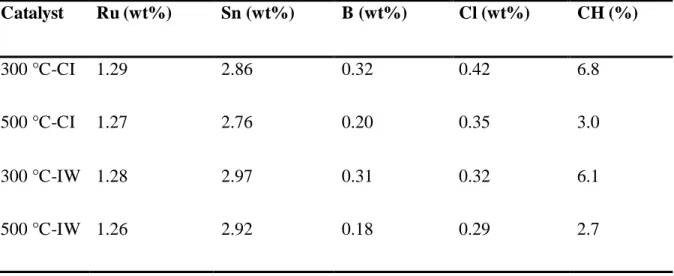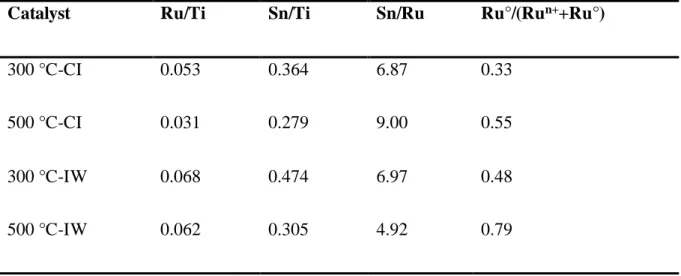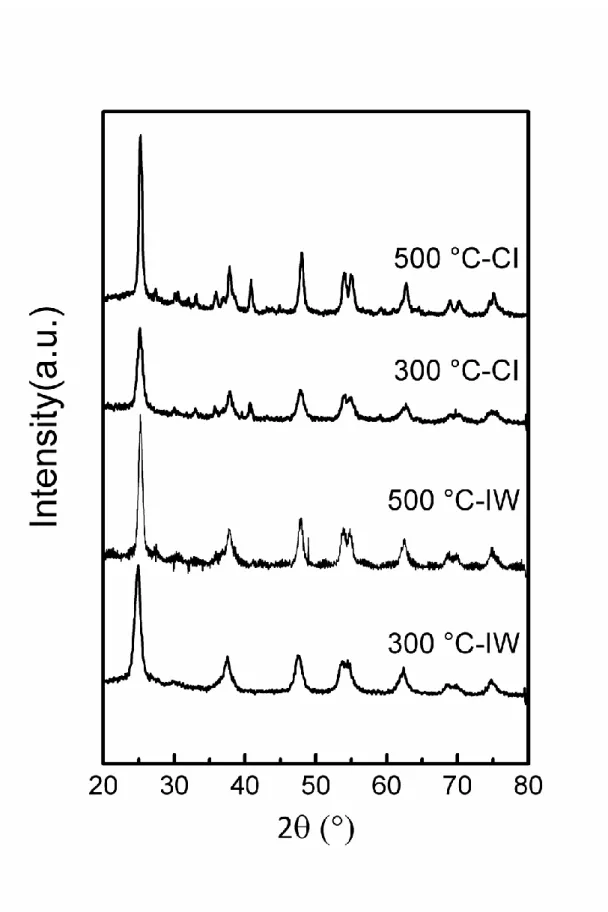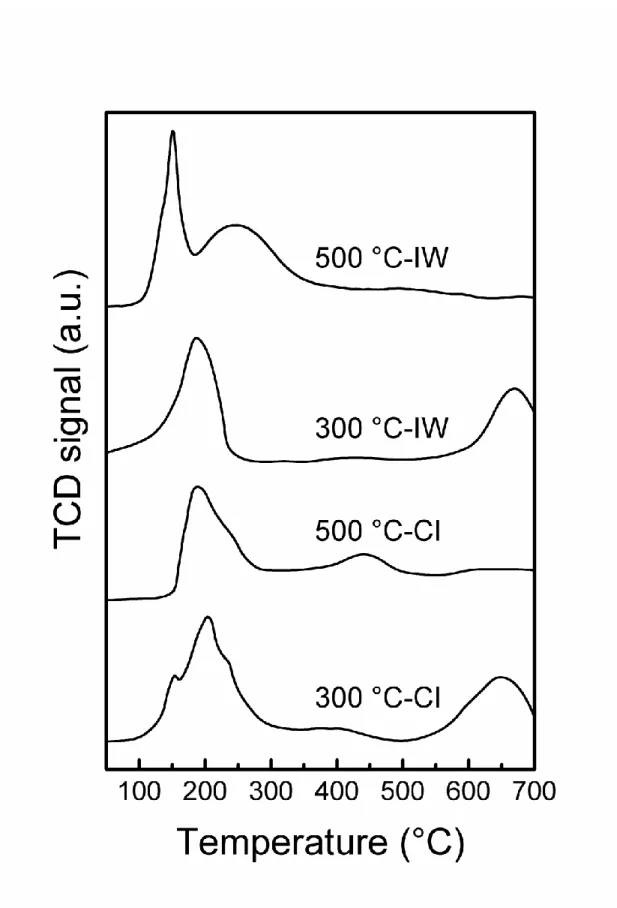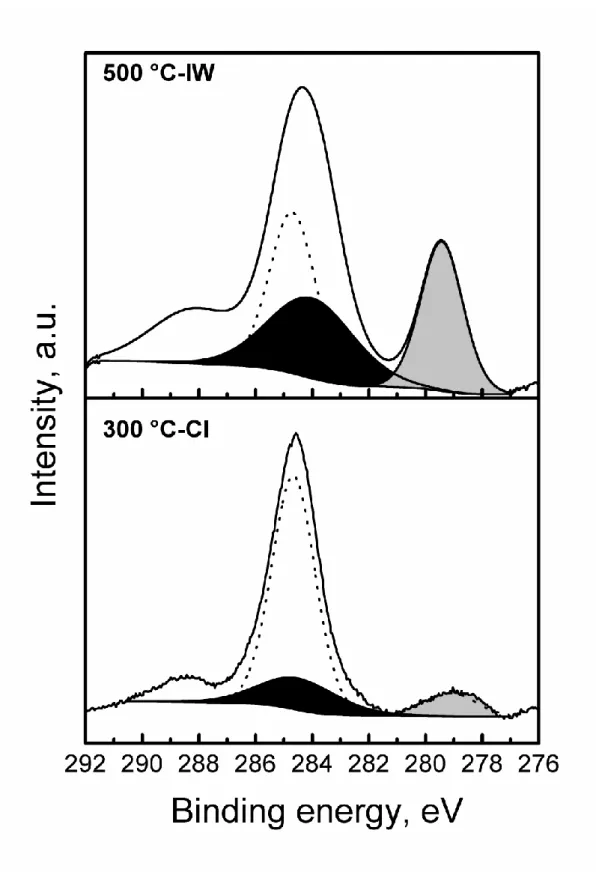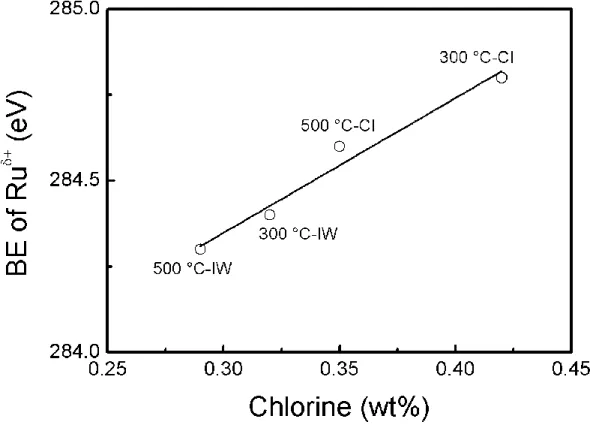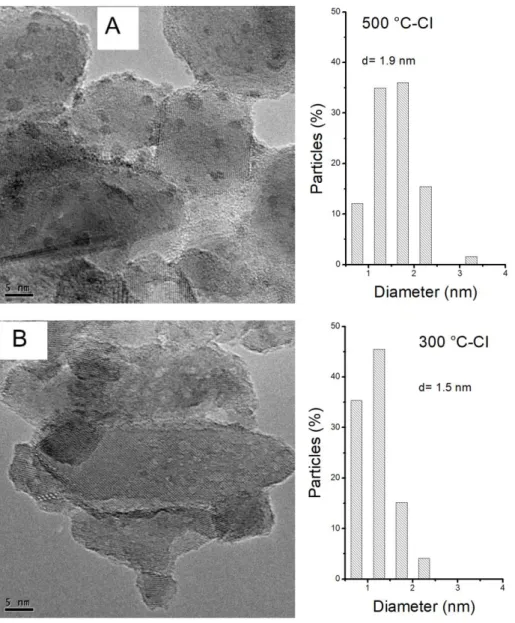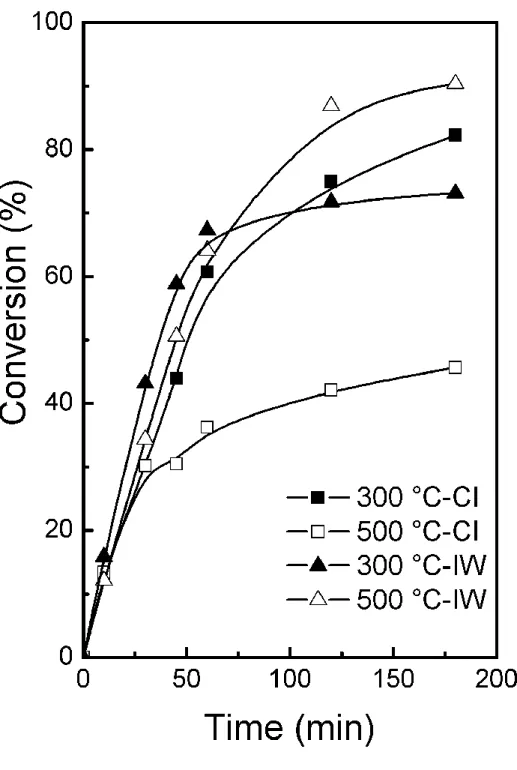HAL Id: hal-02109660
https://hal.archives-ouvertes.fr/hal-02109660
Submitted on 21 Jul 2020HAL is a multi-disciplinary open access archive for the deposit and dissemination of sci-entific research documents, whether they are pub-lished or not. The documents may come from teaching and research institutions in France or abroad, or from public or private research centers.
L’archive ouverte pluridisciplinaire HAL, est destinée au dépôt et à la diffusion de documents scientifiques de niveau recherche, publiés ou non, émanant des établissements d’enseignement et de recherche français ou étrangers, des laboratoires publics ou privés.
Ru-Sn-B/TiO 2 catalysts for methyl oleate selective
hydrogenation. Influence of the preparation method and
the chlorine content
María Sánchez, Vanina Mazzieri, Stéphane Pronier, María Vicerich, Catherine
Especel, Florence Epron, Carlos Pieck
To cite this version:
María Sánchez, Vanina Mazzieri, Stéphane Pronier, María Vicerich, Catherine Especel, et al.. Ru-Sn-B/TiO 2 catalysts for methyl oleate selective hydrogenation. Influence of the preparation method and the chlorine content. Journal of Chemical Technology and Biotechnology, Wiley, 2019, 94 (3), pp.982-991. �10.1002/jctb.5849�. �hal-02109660�
Ru-Sn-B/TiO
2catalysts for methyl oleate selective
hydrogenation. Influence of the preparation method and
the chlorine content
María A. Sánchez1, Vanina A. Mazzieri1, Stéphane Pronier2, María A. Vicerich1,
Catherine Especel2, Florence Epron2, Carlos L. Pieck1
1 Instituto de Investigaciones en Catálisis y Petroquímica (INCAPE) (FIQ-UNL, CONICET),
Colectora Ruta Nac. Nº 168 Km. 0 - Paraje El Pozo - CP 3000, Santa Fe, Argentina
2 Institut de Chimie des Milieux et des Matériaux de Poitiers (IC2MP), Université de Poitiers,
UMR 7285 CNRS, 4 rue Michel Brunet, 86073 Poitiers cedex 9, France
Corresponding author: Carlos L. Pieck
INCAPE
Colectora Ruta Nac. Nº 168 Km. 0 - Paraje El Pozo
3000 Santa Fe, Argentina
Tel. +54-342-4511370
E-mail: pieck@fiq.unl.edu.ar
Orcid ID: orcid.org/0000-0002-5104-3364
Abstract:
Background: Fatty alcohols are produced commercially by selective hydrogenation of fatty
acid esters using copper and chromium catalysts. To reduce drastic reaction conditions, Ru-Sn
catalysts reduced with NaBH4 have been proposed. Chlorine negatively affects the selectivity
and activity of this catalytic system. To get further information on why Cl influences the
selectivity negatively, we studied the influence of the preparation method on titania-supported
catalysts, which leads to catalysts with different chlorine contents.
Results: The activity and selectivity were greatly affected by the chlorine content which
depends on the metal impregnation method (coimpregnation in excess of solution or
coimpregnation by incipient wetness) and the support precalcination. Chlorine affects the
Ru-Sn metal interaction modifying the activity and selectivity. Catalysts with high Ru-Ru-Sn
interaction are more selective to oleyl alcohol. Catalyst prepared by coimpregnation method
exhibits bigger particles than by incipient wetness method, with agglomerated Ru3Sn7 cubic
phase of 50 nm surrounded by amorphous Ru-Sn.
Conclusion: High interaction between Ru and Sn is preferred because segregated Ru species
are not selective for the formation of oleyl alcohol. The electronic state of Ru° is very important
because small variations in the electron density lead s to a decrease in the adsorption of the
hydrogen, or because Ru°-H species do not have the adequate binding energy to produce the necessary “hydride form”. Ru electronic state is modified by the chlorine that surrounds it,
Introduction
Fatty alcohols are important intermediates to produce surfactants, cosmetics and
plasticizers.1 In general, unsaturated fatty alcohols are more expensive than saturated alcohols
because of the additional cost that the process requires to protect the unsaturated C=C double
bond. In 1931, Adkins discovered copper and chromium (Cu/Cr) catalytic systems for the
hydrogenation of esters.2 Similar catalysts are still used for the hydrogenation of fatty acid
esters but require high pressure of reaction (25-30 MPa). To reduce drastic reaction conditions,
Ru-Sn catalysts reduced with sodium borohydride (NaBH4) have been proposed.3-7 In a
previous work, we found that Ru-Sn-B/Al2O3 catalysts prepared by coimpregnation using
incipient wetness method had higher activity and selectivity than catalysts prepared by
coimpregnation with excess solution.8 Besides, catalysts prepared using sodium borohydride
had a high selectivity to oleyl alcohol, whereas Ru-Sn catalysts prepared without B were not
selective for the formation of oleyl alcohol.4 This behavior was attributed to different degrees
of interaction between Ru and Sn.4,9
The support has a strong influence on the performances of the Ru-Sn catalysts used
for the selective hydrogenation of fatty acid or fatty esters to produce oleyl alcohol.7,10,11 The
support can strongly interact with the supported ruthenium oxide, affecting its reducibility,
the size of the particles of Ru and the interaction between Ru and Sn.11-13 In the case of TiO2
support, it was reported the formation of a mixed oxide between tin and titania.14,15 The
catalytic properties of the support are also modified by chlorine introduced by the metal
precursors. In the case of the Ru-Sn/Al2O3 catalysts used for selective hydrogenation of fatty
esters and fatty acids, it has been reported that the presence of Cl negatively affects the
selectivity.7,9,16 For other catalytic systems, the negative influence of chlorine on the activity
reported.17,18 Also, the activity of Ru catalyst is significantly degraded by chlorine in
ammonia synthesis due to its electron-withdrawing property.19
In order to get further information on why Cl influences the selectivity negatively, we
studied the effect of the preparation method on titania-supported catalysts, which leads to
catalysts with different chlorine contents. Two preparation methods (coimpregnation with
excess of impregnation solution and coimpregnation with the exact amount of impregnation
solution, i.e. by incipient wetness) and two support precalcination temperatures (300 and 500
°C) were used.
Experimental
Catalysts preparation.
Support preparation: TiO2 was synthesized from TiCl4 by the technique previously described.20
One part was calcined at 300 °C and another part at 500 °C in a stream of dry air during 4 h to
eliminate any contamination of organic compounds. The heating rate was 2 °C min-1.
Preparation by coimpregnation method (CI) with excess solution: the catalyst was prepared
according to the method described previously.8 Metal precursors (RuCl3.xH2O and
SnCl2.2H2O) as well as sodium borohydride were from Sigma Aldrich (> 99% pure). Briefly,
the support was impregnated with an aqueous solution containing the precursor salts of both
metals (coimpregnation), adding an excess of solution. The solution was allowed to stand for
12 h. Then, the samples were filtered and dried at 120 °C for 24 h in stove. After that the metals
were reduced with an aqueous solution of sodium borohydride, filtered again, washed and dried
at 120 °C for 4 h under nitrogen blanketing. They were then reduced with hydrogen at 300 °C
for 2 h and cooled down in hydrogen to room temperature. Finally, the system was flushed with
Preparation by coimpregnation by incipient wetness method (IW): the catalyst was prepared
according to the same method previously described.11 Briefly, the support was wetted with
exactly the pore volume of an aqueous solution of both metal precursor salts (RuCl3·2H2O, and
SnCl2·2H2O) in the required amounts to achieve the desired metal content. Wetted samples
were left to stand for 12 h, then reduced by the addition of aqueous sodium borohydride, filtered,
washed with water until neutrality, and dried during 4 h at 120 °C under N2 flowing. Finally,
the samples were reduced according to the same protocol as for CI catalyst.
The catalysts were called T °C-IW or T °C-CI, where T is the calcination temperature of
the support (300 or 500 °C), IW and CI are the methods of incorporation of metals
(coimpregnation by incipient wetness or coimpregnation in excess solution, respectively). The
theoretical loadings of Ru and Sn were 1.5 and 3.0 wt%, respectively, using both preparation
methods.
Characterization methods.
Elemental analysis: the composition of the metal phase was determined by inductively coupled
plasma optical emission spectroscopy (ICP-OES, Perkin Elmer, Optima 2100 DV) after
digestion in an acid solution. The chlorine content was determined spectrophotometrically by
the mercury thiocyanate method using a Metrolab 1700 Spectrophotometer.
Textural properties: the specific surface area (BET method), total pore volume, and pore size
distribution (BJH method) were determined by nitrogen adsorption. The catalyst samples were
degassed at 200 °C for 2 h, and then the nitrogen adsorption isotherm was determined at -196
°C with a Micromeritics ASAP 2020.
X-Ray Diffraction (XRD): X-ray diffractograms were performed with a Shimadzu XD-1
diffractometer (CuKα radiation filtered with Ni). The spectra were taken in the range of 2θ
Temperature-Programmed Reduction (TPR): the equipment (Ohkura TP 2002S) and conditions
have been described elsewhere.4 A known mass of catalyst was treated in air at 450 °C for 1 h,
then cooled down to room temperature under air flow. Then, Ar was used for 15 minutes.
Finally, a reducing mixture (5% H2/Ar) was fed and the temperature was increased linearly
from 25 °C to 700 °C at a rate of 10 °C min-1.
Cyclohexane (CH) dehydrogenation: the reaction conditions and the method of analysis of the
reaction products have been reported elsewhere.4 In brief, the catalyst (50 mg) was charged and
activated with H2 (flow rate 36 mL min-1) at 300 °C during 1 h before reaction. The reaction
was carried out at 300 °C, under atmospheric pressure and with a molar ratio H2/CH = 30.
Cyclohexane was provided by Sigma Aldrich (> 99.9% pure).
X-Ray Photoelectron Spectroscopy (XPS): XPS measurements were carried out using a
multitechnique system (SPECS) equipped with a dual Mg/Al X-ray source and a hemispherical
PHOIBOS 150 analyzer (Germany) operating in the fixed analyzer transmission (FAT) mode
following the technique described earlier.4 The XPS analyses were performed on the solids after
treatment with hydrogen/argon at 300 °C. Calibration of the spectra was performed with the Ti
2p3/2 line (455 eV) from a TiO2 support. The data treatment was performed with the Casa XPS
program (Casa Software Ltd., UK).4
Transmission Electron Microscopy (TEM): The analyses were carried out with a Jeol Jem 2100
UHR microscope equipped with a Si (Li) detector for the EDS and a Gatan ultrascan 2kx2k
camera. The samples were prepared in ethanol and placed in an ultrasonic bath without prior
grinding. FFT and electronic diffraction interpretations were performed using the
HIGHSCORE (XRD) software, the ICDD-PDF2 file for searching the sample phases, the
CARINE CRISTALLOGRAPHY software to simulate the projection of diffraction patterns, or
approximately 500 metal particles were observed, and the distribution of particle sizes was
measured. The mean particle diameter (dP) was calculated as the following:
(1)
where ni is the number of particles of diameter di.
Methyl oleate (9-octadecen-1-ol) hydrogenation: The experiments were carried out in a
stainless-steel autoclave reactor (280 cm3 capacity). The reaction conditions (1 g of catalyst,
290 °C and 5 MPa) and the method for the analysis of the reaction products were previously
reported.21 In summary, reaction products were analyzed by GC (Shimadzu GC-200) using a
Chevron ZB-FFAP capillary column (length: 30 m, inner diameter: 0.25 mm), with the
following conditions: injector temperature of 220 °C, column temperature of 200 °C for 1 min,
2 °C min-1 ramp up to 260 °C and then isothermal; detector (FID) temperature of 265 °C; N2
carrier gas. Identification of reaction products was previously done by GC-MS (Shimadzu
QP-5000), using the same capillary column. Only oleyl alcohol, methyl stearate, stearyl alcohol and
methyl oleate were detected as significant compounds in the reactor. The reagents (methyl
oleate and n-dodecane) were provided by Sigma Aldrich (99% purity).
Results and discussion
Table 1 shows the specific surface area, pore volume and pore size values of the studied
catalysts. It is seen that the IW and CI catalysts for the supports calcined at 500 °C have pores
almost twice the size of those calcined at 300 °C, while the surface area is strongly decreased
(from 93 to 38 and 103 to 48 m2 g-1 for the CI and IW samples respectively). In order to
determine whether the specific surface area modification is due to a change in the structure of
the titania support, XRD analyses were performed on the catalysts. Rutile, anatase and brookite
in air at about 600 °C; nevertheless, the transition temperatures vary between 400-1200 °C.22
The wide XRD patterns (Fig. 1) of the samples display five TiO2 diffraction lines centered at
25.3°, 37.8°, 48.0°, 54.9° and 62.8° corresponding to anatase crystal planes.23 It means that the
pre-calcination temperature or preparation method does not modify the support phase structure.
However, the pre-calcination temperature of the support has an influence on the average particle
size of TiO2 anatase. As expected, the estimated average particle size of anatase determined by
the Scherrer formula based on the diffraction peak at 25.3° is high on the support calcined at
higher temperature, as it can be seen in Table 1.
Table 2 displays the metal content values, chlorine percentage and cyclohexane
conversion values obtained for the four catalysts. For all catalysts, the Ru and Sn contents were
slightly lower than the expected theoretical values of 1.5 and 3.0 wt%, respectively. In addition,
Table 2 shows that the catalyst prepared by a given method with the support calcined at 500 °C
has a lower chlorine content than the one prepared on the support calcined at 300 °C. This is
because during the calcination step, the support (TiO2) gives off water, which entrains the
residual chlorine coming from the TiCl4 precursor used for the preparation of the support. The
higher the calcination temperature, the greater the water elimination and consequently, the
lower amount of retained chlorine. The IW method also produces catalysts with lower chlorine
contents, probably due to the more efficient washing performed after the impregnation step of
the metal precursors.
The temperature programmed reduction profiles of Ru and Sn monometallic catalysts
supported on TiO2 calcined at 500 °C were previously reported.11 Boron was found to decrease
the reduction temperature of Ru oxides from 128 to 110 °C, whereas the Sn oxides were reduced
at a higher temperature starting their reduction at 450 °C with a maximum around 600 °C. The
shift in the Ru and Sn reduction temperature peaks shows that both metals were interacting with
prone to give electrons to Ru and remove electrons from Sn. This could explain the different
influence of B on the metal oxides reduction.
Fig. 2 shows that for all bimetallic catalysts the maximum of the reduction peak of Ru
oxides occurs at a higher temperature than for the Ru monometallic catalyst. This could be
because the Sn is in strong interaction with the Ru retarding the reduction. The tin surface
species would inhibit the contact of hydrogen with ruthenium atoms. In addition, when the
support was calcined at 300 °C, a peak attributed to the reduction of segregated Sn species could
be observed at a high temperature (> 600 °C). When the support was calcined at 500 °C, Sn
was reduced at a lower temperature (400 °C and 250 °C for CI and IW catalysts, respectively).
This indicates that there are Sn oxide particles close to Ru of which reduction is catalyzed by
Ru, especially for the IW sample. In conclusion, the TPR results show that for the support
pre-calcined at 500° C there are Ru, Sn and B species in strong interaction, the strongest Ru-Sn
interaction being obtained in the IW catalyst. There are also more segregated Sn particles on
the catalysts prepared with the support pre-calcined at 300 °C than on those prepared on the
support pre-calcined at 500 °C.
Cyclohexane dehydrogenation is a useful reaction to measure the activity of the metallic
function. Additional experiments with the monometallic Sn and Ru catalysts showed that only
the monometallic Ru catalyst was active for cyclohexane dehydrogenation. On the one hand, it is widely known that the reaction is “facile’’ (structure-insensitive) because it does not require
a particular ensemble of neighboring metal atoms to form adsorbate bonds with the proper
strength24,25. On the other hand, benzene is the only reaction product obtained in the reaction
conditions used. Table 2 shows that the lower support pre-calcination temperature leads to
catalysts with the highest values of cyclohexane conversion. In addition, by comparing catalysts
with the same pre-calcination temperature, the IW ones lead to lower conversion values than
the lower activity of the IW catalysts could be due to a higher Ru-Sn interaction or simply
because Ru accessibility is lower on the IW catalysts. Sn would decrease Ru activity because
Sn deposited onto the Ru blocks the active sites (geometrical effect) or there are Sn atoms
deposited near to Ru atoms which modify the electronic state of Ru turning less active
(electronic effect). These results agree with the TPR profiles, since the support calcined at the
lowest temperature showed a higher amount of segregated Sn; consequently, the
dehydrogenating activity of Ru was less affected by Sn. It is important to point out that there is
no correlation between the chlorine content of the catalysts and cyclohexane conversion, since
the reaction is catalyzed by the metal function.
XPS analyses were performed to gain information about the electronic states of the
surface Ru and Sn species. For a sake of simplicity, Fig. 3 only shows the XPS spectra of the
bimetallic 500 °C-IW and 300 °C-CI catalysts, i.e. the best and worst catalysts in relation to the
selectivity to oleyl alcohol. Fig. 3 shows the 276-292 binding energy (BE) range where the
peaks attributed to Ru are located. Since the C 1s peak at 284.6 eV of surface adventitious
carbon overlaps with Ru 3d3/2, the peak of Ru 3d5/2 was employed to determine the chemical
state of Ru in all cases. To make the figure easier to analyze, only the Ru 3 d5/2 peaks are shown.
The XPS results show that Ru° metallic species are present in all catalysts, with BE values in
the range between 279.2 and 280.1 eV, in accordance with the values for metallic Ru reported
in the literature,26-28 while the peak at 284.3-284.8 eV is attributed to Ru 3d5/2 oxidized species.
The preparation method has influence on the reduction of Ru because the Ruδ+ species of the
catalysts prepared by CI method displayed BE values around 0.5 eV higher than that of the IW
catalyst (Figs 3 and 4). These results are confirmed by a higher fraction of Ru°/(Ru°+Ruδ+) for
the IW catalysts reported in Table 3. This phenomenon could be due to chlorine deposited on
the support because the increase in the binding energy of the Ruδ+ species correlates with the
the Ruδ+ by inductive effect as seen in Fig. 4. The harmful effect of chlorine on the reduction
of Ru was also reported in the literature.29-31 Mazzieri et al. speculated that Run+ species on
these catalysts are associated with chlorine species.31
The low BE difference (< 0.5 eV) between Sn2+ and Sn4+ species makes it almost
impossible to distinguish them by XPS. A small peak in the range 484-485 eV and a greater
peak at 486.1 eV were found for the Sn 3d5/2 band (results not shown). According to Rodina et
al., the first peak can be attributed to Sn° and the second one to Snn+ species.32 The
Sn°/(Sn°+Snn +) fraction is lower than 0.2 for all the catalysts. These results agree with those
reported by other authors, since the complete reduction of tin to the zero valent state is very
difficult to achieve.33,34
The Sn/Ti, Ru/Ti and Sn/Ru atomic ratios calculated from the elemental analysis are
about 0.02, 0.01 and 1.92, respectively. The Sn/Ti and Ru/Ti surface atomic ratios obtained by
XPS are displayed in Table 3. The catalysts prepared on the support calcined at 500 °C had
lower Ru/Ti and Sn/Ti surface ratios than those prepared with the support calcined at 300 °C
regardless of the preparation method used. Moreover, by comparing the catalysts prepared on
the support calcined at the same temperature, the CI catalysts had lower Ru/Ti and Sn/Ti surface
atomic ratios than the IW ones. It is important to note that the Ru/Ti and Sn/Ti surface ratios
are much higher than those expected from the bulk analysis, in agreement with the results
reported by Gu et al.35 and Elmasides et al.36 For a 2% Ru/TiO2 catalyst after reduction at 550
°C, Elmasides et al. reported that the surface was dramatically enriched in Ru with a Ru/Ti
surface ratio > 1.36 Similar results were found for Ru-Sn/Al2O3 catalysts, since Rodina et al.
reported that the Sn/Al and Ru/Al surface ratios were ten and four times bigger than the bulk
atomic ratios, respectively.32 The Sn/Ru surface ratio was also higher than the bulk ratio.
XPS data (not shown) indicated a decrease in the amount of chlorinated species at higher
An exhaustive analysis of the samples by TEM and EDX was performed. On the 500
°C-CI catalyst, crystallized Ru-Sn phase agglomerates of 50 nm were observed. The EDX analyses
show a very homogeneous ratio of Sn/Ru = 7/3. The images in FFT and HAADF imaging
confirmed the presence of a Ru3Sn7 phase of cubic structure. Also, small particles (Sn and Ru
phase) and characteristic tin oxide particles with their "great distance" (dhk1 = 0.3359 nm for
plane (110) of tetragonal SnO2) were observed. There are areas consisting essentially of SnO2.
On the 300 °C-CI catalyst, Ru-Sn phase agglomerates, corresponding to Ru3Sn7, of about
50 nm but less well crystallized and more numerous than on 500 °C-CI catalyst were found.
Also, EDX analyses, FFT images as well as HAADF imaging confirmed the presence of Ru3Sn7
phase of cubic structure. There were also very small particles dispersed on TiO2 for which the
diffraction was very difficult to obtain and whose EDX detection was low with a Sn/Ru ratio
of about 4/1. Some particles of Sn oxide were also detected. Complementary large analysis on
dispersed particles showed that Sn/Ru ratio were between 90/10 and 80/20, therefore with
higher Sn contents than on 500 °C-CI catalyst.
In the case of the 500 °C-IW catalyst, very small agglomerates of RuSn2 phase with
particles size of 5 nm were observed. This phase can only be observed in electronic diffraction,
since it seems to be covered by an amorphous phase containing Ru and Sn. There were also
dispersed particles on the support with sizes between 4 and 5 nm (atomic Sn/Ru ratio between
10/90 to 20/80) and between 2 and 3 nm (with metallic contents very variable, Sn/Ru atomic
ratio between 70/30 and 20/80). The electron diffractions demonstrated that the observed phases
are tetragonal RuSn2 and Ru3Sn7.
TEM and EDX analysis of the 300 °C-IW catalyst showed agglomerated particles of
about 30 nm of Ru-Sn phase less crystallized than on 300 °C-CI catalyst. These particles have
a Sn/Ru atomic ratio between 3/7 to 1/1. It is also possible to observe small particles of about
important to point out that the "wide analyses" showed that the Sn/Ru ratios are 30/70 or 80/20.
Therefore, the bimetallic particles are very heterogeneous. Also, particles dispersed on TiO2
with atomic Sn/Ru ratio about 5/95 were found by EDX analyses.
It should be noted that in all the catalysts there was a difference between the Sn/Ru ratio
determined by the crystallographic structures and the EDX analyses. This could be explained
by the fact that the particles are crystallized but they undoubtedly contain an amorphous
surrounded Ru-Sn metal phase. The “wide analysis” by EDX of the surface shows that Sn/Ru
atomic ratio on the IW catalysts is lower than on the CI catalysts.
Figs 5 and 6 show typical TEM pictures and metal size distribution corresponding to CI
and IW catalysts, respectively. It is important to point out that the big agglomerates of about
30-50 nm were not considered for calculating the metal size distribution, which probably leads
to an underestimation of the mean metallic particle size, especially on CI catalysts.
Fig. 7 shows the methyl oleate conversion as a function of the reaction time. All the
catalysts showed a similar initial activity. Differences in catalytic activity started to be marked
at about 60 min. Catalysts with high cyclohexane dehydrogenation activity also had high
hydrogenation activity to convert methyl oleate (Table 2 and Fig. 7), except for the 500 °C-IW
catalyst, which presents the lowest cyclohexane conversion but the highest methyl oleate one
at the end of the reaction. This might indicate that both reactions take place on different active
sites. Cyclohexane dehydrogenation occurs on surface Ru, while Sn is inactive and even
negatively affects the Ru activity by an electronic or geometric effect.The geometric effect
involves the blocking of active Ru ensembles by the added modifier atoms. The electronic effect
corresponds to the modification of the Ru electronic density due to an interaction with Sn
neighboring atoms. Such electronic modification would in turn change the adsorption energy
of the chemical species participating in the catalytic reaction. It has been proved that both
Sn in strong interaction.4,6,28,39-41 More recently, Rodina et al. proposed that crystalline RuxSny
structures with variable composition were the active component of the selective hydrogenation
catalyst.32 The high activity was attributed to Ru° sites interacting with Sn2+ or Sn4+ Lewis acid
sites.6 It is also possible that the lower chlorine content of the 500 °C-IW catalyst favors the
conversion of methyl oleate because chlorine decreases the Ru-Sn interaction.7,9
Fig. 8 shows conversion values at the end of the reaction as a function of the Sn/Ru atomic
ratio obtained by XPS. As the Sn/Ru ratio increases, the catalyst appears to be less active. At
high Sn/Ru ratios, Sn could encapsulate Ru and thereby block its catalytic activity. Fig. 9 shows
values of selectivity to oleyl alcohol (desired product) as a function of reaction time. As
expected, selectivity goes through a maximum as a function of the reaction time since oleyl
alcohol is an intermediate reaction product, being transformed to stearyl alcohol at higher
reaction times. Sn/Ru atomic ratios equal to 2 or 4 have been reported as the optimal values
favoring the formation of the unsaturated alcohol.3,7,28,41 The values reported in Table 3 show
that the prepared catalysts have a Sn/Ru surface ratio much higher than the optimum. By EDX
analysis, it was found that only the catalyst 500 °C-IW, the most selective to oleyl alcohol,
displays the RuSn2 tetragonal phase.
In addition, catalysts prepared with the support previously calcined at 500 °C are seen to
be more selective to the desired product (oleyl alcohol) than those prepared with the support
calcined at 300 °C regardless of the preparation method. As previously reported, good
selectivity to oleyl alcohol is achieved when there is a strong Ru-Sn interaction. TPR and
cyclohexane dehydrogenation have shown that a previous calcination of the support at 500 °C
leads to a strong Ru-Sn interaction, probably due to the elimination of chlorine. Echeverri et al.
have reported that chlorine prevents a strong interaction between Ru and Sn species, thus
Fig. 10 shows the selectivity to oleyl alcohol, the sum of the selectivities to stearyl alcohol
and methyl stearate, and the sum of the selectivity to oleyl and stearyl alcohol as a function of
the activity for dehydrogenation cyclohexane. With the increase in the cyclohexane
dehydrogenation activity, the selectivity to oleyl alcohol decreases as well as the selectivity to
oleyl alcohol + stearyl alcohol. This can be explained by considering that cyclohexane
dehydrogenation is catalyzed by Ru, while the selective hydrogenation of methyl oleate to oleyl
alcohol occurs on Ru species in strong interaction with Sn. Besides, the sum of the selectivities
to stearyl alcohol and methyl stearate, i.e. the selectivity for hydrogenation of the C=C double
bond increases with the cyclohexane dehydrogenation activity. This indicates that isolated Ru
preferably hydrogenates the C=C double bond.
Fig. 11 shows the maximum selectivity to oleyl alcohol obtained in each catalyst as a
function of the chlorine content. The higher selectivity to oleyl alcohol is obtained on the
catalyst of lower Cl content. However, this correlation is not linear and after a certain threshold
value, the ability to produce oleyl alcohol remains constant.
To explain the results, it is necessary to analyze the reaction mechanism and the active
sites involved in the reaction. The reaction mechanism proposed for the selective hydrogenation
of methyl oleate to oleyl alcohol is direct hydrogenation or stepwise hydrogenation via the
formation of an aldehyde intermediate.6,28 In both mechanisms, the oxygen of the C=O group
is bonded to Sn oxides species which must be in strong interaction with Ru.3,6,7,28 A similar
model was proposed for the Ru-Sn-B/TiO2 catalyst where the Sn oxides species are replaced
by Ti3+ species.12 Basically, the direct hydrogenation mechanism proposes that electron-rich
Ru° activates the H2 into a “hydride form”. Sn2+ or Sn4+ Lewis acid sites, which are in
interaction with Ru, polarize the carbonyl of the ester, facilitating the hydrogen transfer from
an adjacent Ru-H site. The hydrogen activated on ruthenium attacks the carbon atom of the
The chlorine present in the support would modify the electronic state of Ru, mainly of the
Ru oxidized species (changing the BE, see Fig. 4). By inductive effect , the electronic state of
the Ru° is also changed. Moreover, chlorine inhibits the reduction of Ru to the metallic state
(Table 3). Therefore, the adsorption of hydrogen on Ru° is disturbed. This alters the attack by
the hydrogen of the carbon atom of carbonyl group, thus leading to a lower selectivity to
alcohol. The active sites for the reaction proposed by several researchers are formed by Sn and
Ru in strong interaction with Sn/Ru atomic ratio of 2.3,7,41 The TEM and EDX results showed
that 500 °C-IW catalyst, the most selective to oleyl alcohol, possesses the highest amount of
RuSn2 tetragonal phase and big agglomerates of Ru3Sn7 phase were not observed.
The main advantage of the Ru-Sn-B/TiO2 catalyst in comparison to the commercial
copper chromite catalyst is the drastic reduction of the working pressure to 3-5 MPa, while the
reaction temperature is similar. The commercial processes also have a higher yield to stearyl
alcohol.21 However a higher yield to fatty alcohol could be obtained in our case by optimizing
the reaction conditions, especially the residence time, because stearyl alcohol is the final
reaction product. In this sense high selectivity to stearyl alcohol could be obtained at high values
of residence time in a continuous reactor. Long residence times would be obtained at high
values of the catalyst mass to feed flowrate ratio.
Conclusions
It was found that the activity and selectivity were greatly affected by the chlorine content
which depend on, the metal impregnation method (coimpregnation by incipient wetness or in
excess solvent) and the support pre-calcination treatment. It has been proved that it is better to
pre-treat the support at high temperature (500 °C) to remove more chlorine to obtain more
The electronic state of Ru° is very important because small variations in the electron
density lead to a decrease in the adsorption of the hydrogen. This electronic state is modified
by the chlorine surrounding the Ru atoms.
Catalysts prepared by CI method exhibit bigger agglomerated Ru3Sn7 cubic phase of 50
nm surrounded by amorphous Ru-Sn than those prepared by the IW method. However, big
agglomerates are also found on the 300 °C-IW catalyst but they are smaller (30 nm). The 500
°C-IW catalyst does not present big agglomerates. CI catalysts present a bimodal particles size
distribution, with small particles lower than 2.5 nm and agglomerates of 50 nm. The wide
analysis by EDX of the surface shows that Sn/Ru atomic ratio determined on the IW catalysts
is lower than on the CI catalysts.
The experimental results clearly show that sites involved in the hydrogenation of methyl
oleate and in the dehydrogenation of cyclohexane are different.
Acknowledgements
This work had the financial support of Consejo Nacional de Investigaciones Científicas
y Técnicas and the Universidad Nacional del Litoral (Project CAI+D) - Argentina.
References
1 Knaut J and Richtler HJ, Trends in industrial uses of palm and lauric oils. J Am Oil Chem
Soc 62:317-27 (1985).
2 Adkins H and Connor R, The catalytic hydrogenation of organic compounds over copper
chromite. J Am Chem Soc 53:1091-5 (1931).
3 Narasimhan CS, Deshpande VM and Ramnarayan K, Selective hydrogenation of methyl
4 Sánchez MA, Mazzieri VA, Sad MR, Grau R and Pieck CL, Influence of preparation
method and boron addition on the metal function properties of Ru-Sn catalysts for selective
carbonyl hydrogenation. J Chem Technol Biotechnol 86:447-53 (2011).
5 Piccirilli A, Pouilloux Y, Pronier S and Barrault J, Selective hydrogenation of methyl
oleate into oleyl alcohol in the presence of ruthenium-tin-supported catalysts. Bull Soc Chim Fr
132:1109-17 (1995).
6 Deshpande VM, Ramnarayan K and Narasimhan CS, Studies on ruthenium-tin boride
catalysts II. Hydrogenation of fatty acid esters to fatty alcohols. J Catal 121:174-82 (1990).
7 Cheah KY, Tang TS, Mizukami F, Niwa S ichi, Toba M and Choo YM, Selective
hydrogenation of oleic acid to 9-octadecen-1-ol: Catalyst preparation and optimum reaction
conditions. J Am Oil Chem Soc 69:410-6 (1992).
8 Sánchez MA, Mazzieri VA, Sad MR and Pieck CL, Influence of the operating conditions
and kinetic analysis of the selective hydrogenation of methyl oleate on Ru-Sn-B/Al2O3
catalysts. React Kinet Mech Catal 107:127-39 (2012).
9 Echeverri DA, Marín JM, Restrepo GM and Rios LA, Characterization and carbonylic
hydrogenation of methyl oleate over Ru-Sn/Al2O3: Effects of metal precursor and chlorine
removal. Appl Catal A Gen 366:342-7 (2009).
10 Mendes M. J, Santos OAA, Jordão E and Silva AM, Hydrogenation of oleic acid over
ruthenium catalysts. Appl Catal A Gen 217:253-62 (2001).
11 Sánchez MA, Mazzieri VA, Vicerich MA, Vera CR and Pieck CL, Influence of the
Support Material on the Activity and Selectivity of Ru-Sn-B Catalysts for the Selective
Hydrogenation of Methyl Oleate. Ind Eng Chem Res 54:6845-54 (2015).
12 Corradini SA d. S, Lenzi GG, Lenzi MK, Soares CMF and Santos OAA, Characterization
and hydrogenation of methyl oleate over Ru/TiO2, Ru-Sn/TiO2 catalysts. J Non Cryst Solids
13 Bond GC, Preparation and properties of vanadia/titania monolayer catalysts. Appl Catal
A Gen 157:91-103 (1997).
14 Oliveira MM, Schnitzler DC and Zarbin AJG, (Ti,Sn)O2 mixed oxides nanoparticles
obtained by the sol-gel route. Chem Mater 15:1903-9 (2003).
15 Lin J, Yu JC, Lo D and Lam SK, Photocatalytic activity of rutile Ti1-xSnxO2 solid
solutions. J Catal 183:368-74 (1990).
16 Ishii K, Mizukami F, Niwa S, Toba M, Ushijima H and Sato T, Effects of raw materials
and preparation methods of catalysts on the selective hydrogenation of ethyl phenylacetate. J
Am Oil Chem Soc 73:465-9 (1996).
17 Ragaini V, Carli R, Bianchi CL, Lorenzetti D and Vergani G, Fischer-Tropsch synthesis
on alumina-supported ruthenium catalysts I. Influence of K and Cl modifiers. Appl Catal A
Gen, 139:17-29 (1996).
18 Narita, T, Miura H, Ohira M, Hondou H, Sugiyama K and Matsuda T, The effect of
reduction temperature on the chemisorptive properties of Ru/Al2O3: Effect of chlorine. Appl
Catal 32: 185-190 (1987).
19 Li J, Kitano M, Ye T, Sasase M, Yokoyama T and Hosono H, Chlorine‐Tolerant Ruthenium Catalyst Derived Using the Unique Anion‐Exchange Properties of 12 CaO.7 Al2O3
for Ammonia Synthesis. ChemCatChem 9: 3078-3083 (2017).
20 Benítez VM, Yori JC, Vera CR, Pieck CL, Grau JM and Parera JM, Characterization of
transition-metal oxides promoted with oxoanions by means of test reactions. J Ind Eng Chem
Res 44:1716-21 (2005).
21 Sánchez MA, Mazzieri VA, Oportus M, Reyes P and Pieck CL, Influence of Ge content
on the activity of Ru-Ge-B/Al2O3 catalysts for selective hydrogenation of methyl oleate to oleyl
alcohol. Catal Today 213:81-6 (2013).
Mater Sci 46:855-74 (2011).
23 Wu L, Yu JC, Wang X, Zhang L and Yu J, Characterization of mesoporous
nanocrystalline TiO2 photocatalysts synthesized via a sol-solvothermal process at a low
temperature. J Solid State Chem 178:321-8 (2005).
24 Gault FG, Mechanisms of skeletal isomerization of hydrocarbons on metals. Adv. Catal.
30:1-95 (1981)
25 Boudart M, Aldag A, Benson JE, Dougharty VA and Harkings CG, On the specific
activity of platinum catalysts. J. Catal. 6:92-99 (1966).
26 Xie S, Qiao M, Li H, Wang W and Deng J-F, A novel Ru-B/SiO2 amorphous catalyst
used in benzene-selective hydrogenation. Appl Catal A Gen 176:129-34 (1999).
27 Moulder JF, Stickle WF, Sobol PE and Bomben KD, Handbook of X-ray Photoelectron
Spectroscopy, ed by Chastain J, (1992).
28 Pouilloux Y, Autin F, Guimon C and Barrault J, Hydrogenation of Fatty Esters over
Ruthenium-Tin Catalysts; Characterization and Identification of Active Centers. J Catal
176:215-24 (1998).
29 Van Der Steen PJ and Scholten JJF, Selectivity to cyclohexene in the gas phase
hydrogenation of benzene over ruthenium, as influenced by reaction modifiers: II. Catalytic
hydrogenation of benzene to cyclohexene and cyclohexane. Appl Catal 58:291-304 (1990).
30 Milone C, Neri G, Donato A, Musolino MG and Mercadante L, Selective Hydrogenation
of Benzene to Cyclohexene on Ru/γ-Al2O3. J Catal 159:253-8 (1996).
31 Mazzieri VA, Coloma-Pascual F, Arcoya A, L’Argentière PC and Fígoli NS, XPS, FTIR
and TPR characterization of Ru/Al2O3 catalysts. Appl Surf Sci 210:222-30 (2003).
32 Rodina VO, Ermakov DY, Saraev AA, Reshetnikov SI and Yakovlev VA, Influence of
reaction conditions and kinetic analysis of the selective hydrogenation of oleic acid toward fatty
33 Adkins SR and Davis BH, The chemical state of tin in platinum-tin-alumina catalysts. J
Catal 89:371-9 (1984).
34 Sexton BA, Hughes AE and Foger K, An X-ray photoelectron spectroscopy and reaction
study of Pt-Sn catalysts. J Catal 88:466-77 (1984).
35 Gu Q, Long J, Fan L, Chen L, Zhao L and Lin H, Single-site Sn-grafted Ru/TiO2
photocatalysts for biomass reforming: Synergistic effect of dual co-catalysts and molecular
mechanism. J Catal 303:141-55 (2013).
36 Elmasides C, Kondarides DI, Grünert W and Verykios XE, XPS and FTIR Study of
Ru/Al2O3 and Ru/TiO2 Catalysts: Reduction Characteristics and Interaction with a
Methane-Oxygen Mixture (1999).
37 Parera, JM and Fígoli NS, Reactions in the commercial reformer, in Catalytic Naphtha
Reforming: Science and Technology, ed by Antos GJ, Aitani AM and Parera JM. Marcel Dekker
Inc., Marcel Dek. New York, pp 45-78 (1995).
38 Edgar MD, Catalytic Reforming of Naphtha in Petroleum Refineries, in Applied
Industrial Catalysis, ed by Bruce EL, Academic Press, New York, pp 124-48 (1983).
39 Luo G, Yan S, Qiao M, Zhuang J and Fan K, Effect of tin on Ru-B/γ-Al2O3 catalyst for
the hydrogenation of ethyl lactate to 1,2-propanediol. Appl Catal A Gen 275:95-102 (2004).
40 Pouilloux Y, Piccirilli A and Barrault J, Selective hydrogenation into oleyl alcohol of
methyl oleate in the presence of Ru-SnAl2O3 catalysts. J Mol Catal A Chem 108:161-6 (1996).
41 Sánchez MA, Mazzieri VA, Vicerich MA, Vera CR and Pieck CL, Ru-Sn-B/Al2O3
catalysts for selective hydrogenation of methyl oleate: Influence of the Ru/Sn Ratio. J of Chem
2015:1-7 (2015).
42 Yuan P, Liu ZY, Zhang WQ, Sun HJ, Liu SC, Cu-Zn/Al2O3 Catalyst for the
Table 1. Surface area, pore volume, pore size and average particle size determined for the four
studied catalysts.
Physical property 300 ºC-CI 500 ºC-CI 300 ºC-IW 500 ºC-IW
Surface area (m2 g-1) 93 38 103 48
Pore volume (cm3 g-1) 0.21 0.22 0.25 0.25
Pore size (nm) 7.3 16.6 7.2 15.2
TiO2 average particle size (nm)* 9 14 9 16
Table 2: Ru, Sn, B and chlorine contents, and cyclohexane conversion of TiO2 supported
catalysts prepared by different methods at different pre-calcination temperatures.
Catalyst Ru (wt%) Sn (wt%) B (wt%) Cl (wt%) CH (%) 300 °C-CI 1.29 2.86 0.32 0.42 6.8 500 °C-CI 1.27 2.76 0.20 0.35 3.0 300 °C-IW 1.28 2.97 0.31 0.32 6.1 500 °C-IW 1.26 2.92 0.18 0.29 2.7 CH: cyclohexane conversion
Table 3. Surface atomic ratio of Ru and Sn species determined by XPS.
Catalyst Ru/Ti Sn/Ti Sn/Ru Ru°/(Run++Ru°)
300 °C-CI 0.053 0.364 6.87 0.33
500 °C-CI 0.031 0.279 9.00 0.55
300 °C-IW 0.068 0.474 6.97 0.48
Figure 1. XRD patterns of the catalysts prepared by IW and CI method on the titania support
Figure 2. TPR of the catalysts prepared by IW and CI method on the titania support calcined
Figure 3. XPS spectra in the Ru 3d region of the 500 °C-IW and 300 °C-CI catalysts. Grey
shaded peak, black shaded peak and dashed line correspond s to Ru°, Ruδ+ and C 1s,
Figure 4. Binding energy of the Ruδ+ species in the Ru 3d5/2 region as a function of the chlorine
Figure 5: TEM pictures and particle size distributions of (A) 500 °C-CI catalyst (630 particles
Figure 6: TEM pictures and particle size distributions of (A) 500 °C-IW catalyst (491 particles
Figure 7. Conversion of methyl oleate as a function of the reaction time obtained with the four
Figure 8. Conversion of methyl oleate at 180 min reaction time as a function of the Sn/Ru
Figure 9. Selectivity to oleyl alcohol as a function of the reaction time obtained with the four
Figure 10. Selectivity to oleyl alcohol, the sum of the selectivity to stearyl alcohol and methyl
stearate and the sum of the selectivity to oleyl alcohol and stearyl alcohol as a function of the
Figure 11. Maximum selectivity to oleyl alcohol obtained in each catalyst as a function of the
